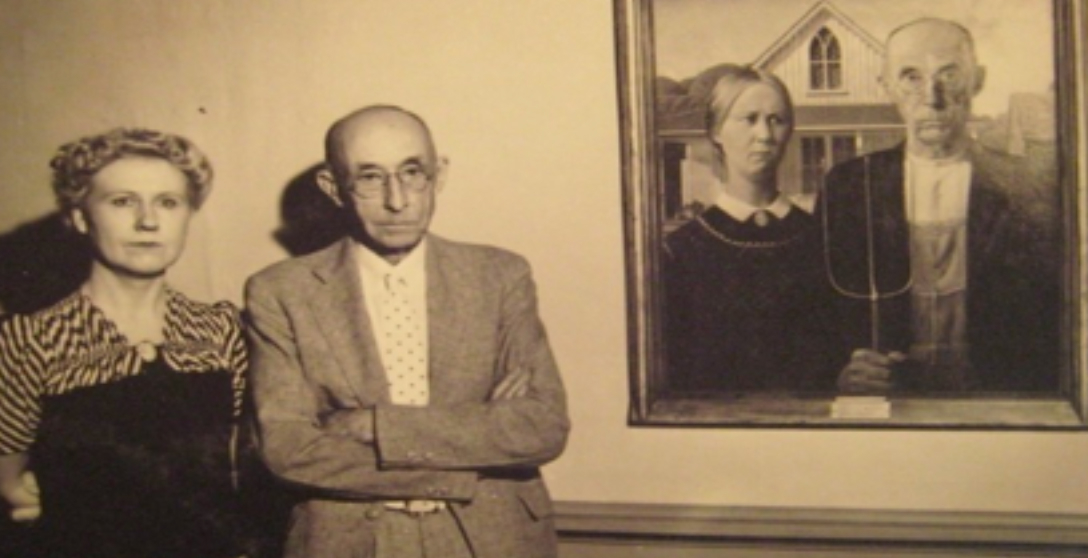
Photographic capture of models for Grant Wood’s iconic 1930 painting American Gothic.
Grant Wood (Feb 1891-Feb1942) was inspired to paint his most famous work American Gothic in 1930 when driving through the Iowa landscape with a fellow artist – when he discovered the classic, ‘Dibble House.’ It was not until he returned to his studio in Cedar Rapids, that he added the element of portraiture and had the idea to include portraits of “the kind of people he imagined would live in that specific Gothic house.“
The wonderful photo shown here captures the very principle I want you to consider when interpreting art imagined. In this instance, we are looking at a portrait within a portrait which is made all the more interesting by the fact that these are the real models Grant Wood choose to portray as a rural Midwest American farmer and his wife. In reality they were his sister, Nan Wood & his Dentist. Many people regard this painting, American Gothic, as the most Iconic painting of 20th Century American Art.Let’s try to understand why.
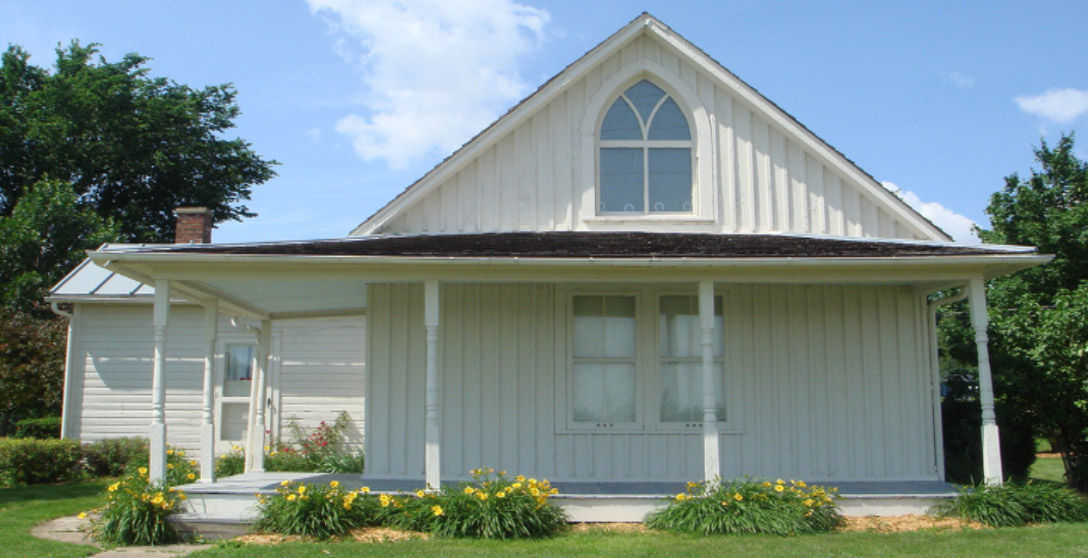
What do we mean by the term iconic. Why is this painting often referred to as the most iconic American painting?
Definition: An important and enduring object or place which gains great attention and devotion. A symbol which is instantly recognized and or linked to place, such as the Eiffel Tower & Paris.
Grant Wood had an informal introduction to art and eventually took himself off to Europe to study further & to learn from past painting masters. In 1928, two years prior to painting his iconic American Gothic, he found himself living in Munich, Germany. While in Munich he was greatly influenced by the N. Renaissance painters such as Albrecht Durer and Jan van Eyck. He was drawn to their fine painting techniques and attention to details, especially with portraiture. This period of painting was also very much focused on humanism and its values. Studying the works directly from this period had a longstanding influence on Wood’s art practice thereafter.
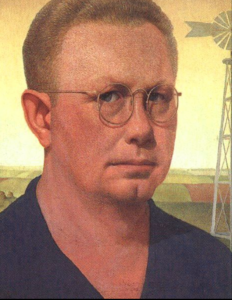
Self portrait Grant Wood, 1932
Once American Gothic was completed, using his sister and Dentist as the farming couple, Wood decided to submit the painting in an important art competition at The Art Institute of Chicago. He won a Bronze medal with American Gothic and eventually the AIC purchased the painting for the sum of $300 to include in their permanent collection. It was the people’s choice and reproduced extensively in numerous publications and papers of the time.
The success of the painting did not go down as well in Cedar Rapids, Iowa, where Wood lived. “Iowans were furious at their depiction as pinched, grim-faced and puritanical.” Grant Wood protested that he had not painted a caricature of Iowans but rather a depiction of his appreciation of them, stating … “I had to go to Europe to appreciate Iowa.”
Art critics of the time such as Gertrude Stein insisted the painting was meant to satire small-town rural life in America; however, with the onset of the Great Depression the painting came eventually to be seen instead as a depiction of the steadfast American pioneer spirit.
The characters presented by Wood and so carefully placed in front of the inspiring Dibble House were created through his imagination originally, but based on the humanist details and facial characteristics of two known individuals who really existed but symbolized to Wood the essence of the American Midwest character.
This extraordinary painting became an iconic image to several generations of Americans, because it allowed them to see in it what they desired to see in themselves and what they felt it meant to be an American i.e. the pioneer spirit.
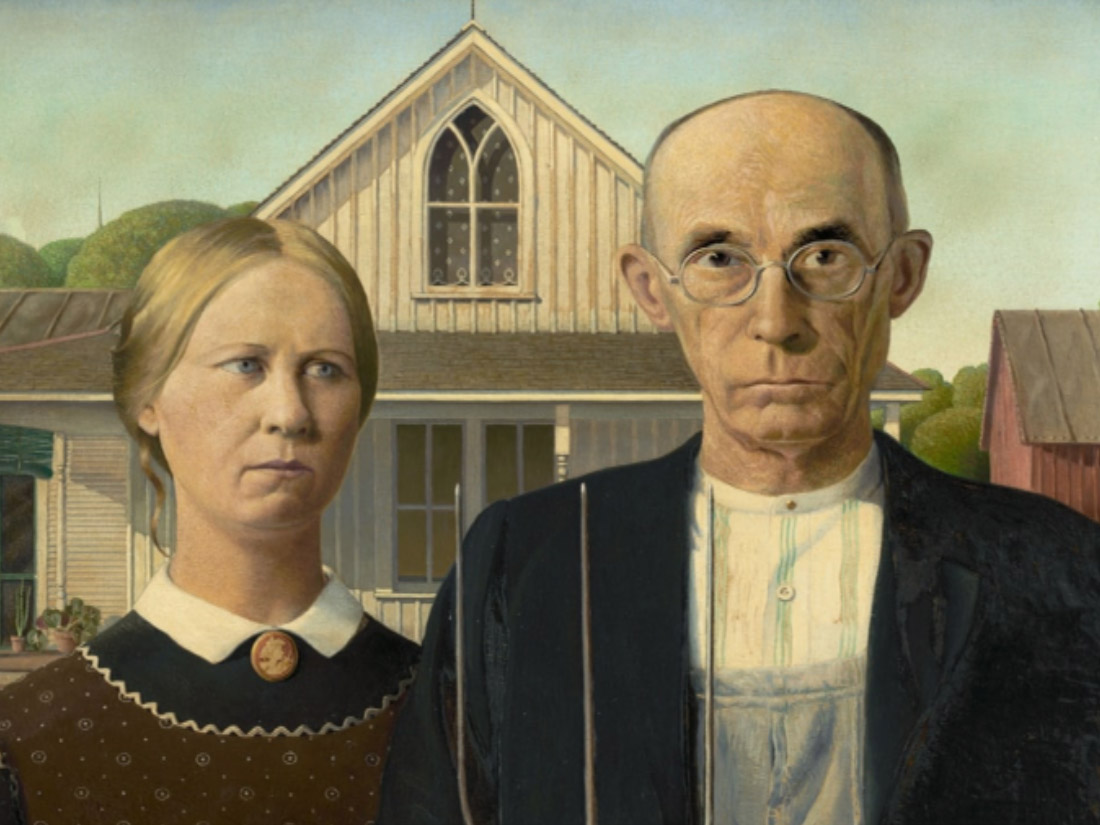
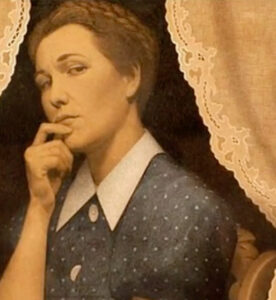 Wood went on in his artistic career to develop a painting movement – style, which was later to be known as ‘Regionalism.’ He spent most of his life living in a rural situation through choice, and his work focused specifically on the Midwest of America and its people, his land.
Wood went on in his artistic career to develop a painting movement – style, which was later to be known as ‘Regionalism.’ He spent most of his life living in a rural situation through choice, and his work focused specifically on the Midwest of America and its people, his land.
Seldom has an artist been so associated with one painting and although his career covered several decades, once he returned from his studies in Europe his style remained unchanged. There is much to be admired about his choice to focus inwardly and remain true to his origins despite pressure to perhaps shift his focus to the urban cities where more opportunities may have been found there for him.
I do wonder if Grant Wood were transported to Australia and to this challenging time of global pandemic that we are experiencing – how he would choose to represent our time, or the iconic Australian face and landscape? I am interested in your thoughts as to what other artists and which works you would describe as iconic? Can you think of an Australian artist past or present who has been able to capture the true character of our Australian culture. Please send me your ideas.
Note: For a short introduction and an eloquent description of Grant Wood’s art practice suggest a look at this clip prepared by NYC’s Whitney Museum Curator, Barbara Haskell.




